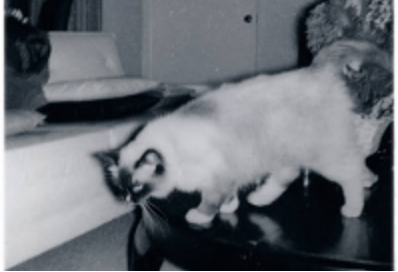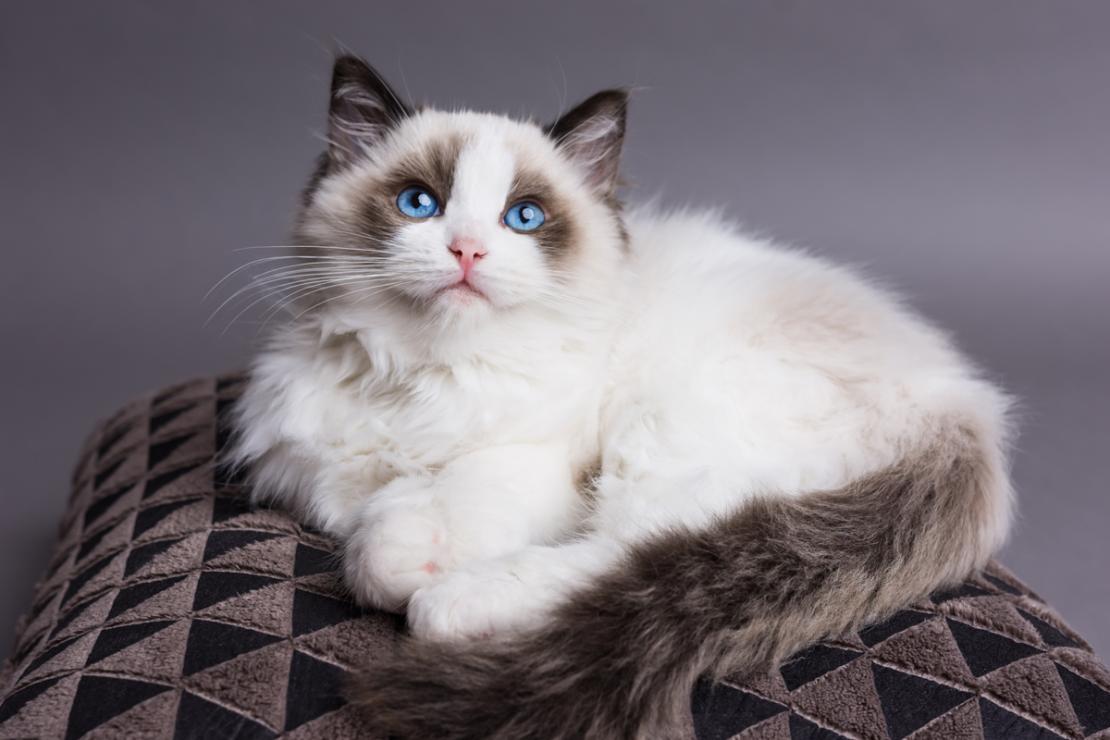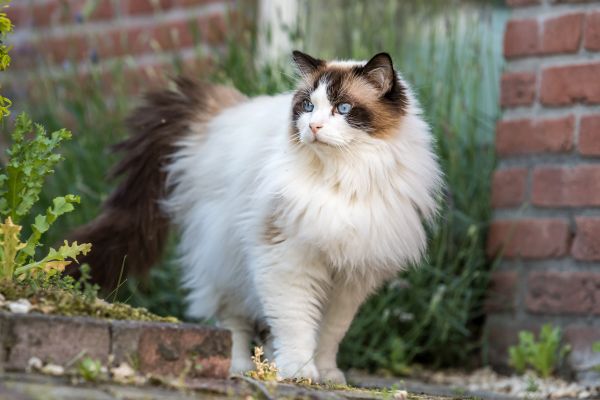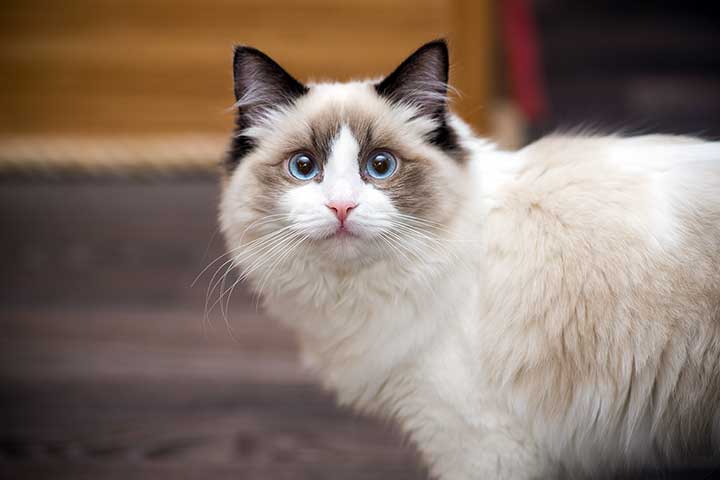Ragdoll is the English name for a doll made of cloth or rags. If you pick up the large house cat of the same name with its silky fur and attractive markings, it will sag in a similar way to these soft dolls. This cat is also an extremely affectionate housemate who accompanies you wherever you go.
Table of Contents
History of the Ragdoll
A patent cat: The impressive floppy cat is the only cat breed for which a patent has been applied for. The systematic breeding of this semi-longhair cat began in California in the 1960s. The original mother of all floppy cat was a long-haired cat named Josephine. She had a litter of noticeably large kittens with semi-long fur, Birman-like markings and blue eyes. Cat lover Ann Baker took over one of these kittens and started a legally protected line breeding with him and a few other animals. She chose “Ragdoll” as the name because when she carried her, her cats would hang down relaxed and limp like a doll.
The large cats with the beautiful markings quickly grew in popularity. Therefore, Ann Baker demanded royalties for every animal given away and imposed strict conditions on other cat lovers for continued breeding. Because of these requirements, there was hardly any offspring.

Fortunately, some cat breeders had already purchased cats from Ann Baker before the floppy cat breed was patented. It is largely thanks to the commitment of Georgeann and Dave Chambers as well as Laura and Denny Dayton that the floppy cat breed exists with today’s breeding standards.
In 19881 the first Ragdoll breeding animals came to Europe from the USA and spread quickly. In 1992, the international umbrella organization of cat breeders, the Fédération Internationale Féline (FIFe), recognized the floppy cat as an independent breed.
Ragdoll: character and attitude
The floppy cat reaches a shoulder height of up to 40 centimeters. With a length of 100 to 120 centimeters from nose to tail, it is one of the largest domestic cats in the world. In terms of weight, tomcats weigh around 6.5 to 10 kilograms. Female cats range between 4.5 and 6.5 kilograms.
Despite these impressive dimensions, floppy cat have a very gentle, even-tempered nature. They move through the apartment surprisingly elegantly and mindfully. Their size and silky fur make them look extremely royal and noble.
The cuddly furry friends bond closely with humans and are loyal, affectionate companions. Like a dog, the ragdolls follow you wherever you go. They watch what you do with interest and prefer to sleep very close to you. Due to its open-minded and peace-loving character, the Ragdoll is an ideal family cat. She is a stranger to aggression and has an amazing level of patience and tolerance. This means that this velvet paw gets along excellently with children or dogs.

Ragdolls love to be carried around by their caregivers. If you feel good, your muscles relax as you then relax completely. This is how their name came about: Ragdoll means rag or rag doll. When held in her arms, the big kitty actually looks like a soft rag doll with dangling limbs.
The floppy cat is particularly suitable for cat fans who would like to have their pet around them at all times. The docile, attentive animals act like a dog: they greet you happily when you come home, accompany you throughout the house and prefer to be right in the middle of the action.
Characteristics of Ragdoll
| Race | Ragdoll |
| Origin | California/USA |
| Size | very large, up to 40 centimeters shoulder height, head-tail length up to 120 centimeters |
| Weight | Cat 4.5 to 6.5 kilograms, tomcat 6.5 to 10 kilograms |
| Anatomy | strong, long-legged and muscular, shoulder height up to 40 centimeters, broad chest, bushy tail, round paws |
| Head shape | medium-sized and wedge-shaped, ears with small tufts of hair, round muzzle with a pronounced chin |
| Eyes | oval and bright blue |
| Fur and color | Semi-Langaar, silky-smooth texture, recognized colors are black, lilac, blue and chocolate with various patterns |
| Grooming | Comb several times a week |
| Particularities | The body usually relaxes when lifted and literally goes limp |
| Character | Affectionate, gentle, playful, strong character |
Keeping and caring for the Ragdoll
Ragdoll cats like attention. Whether playing with other dogs or the house dog, cuddling with children or being cuddled by you – these gentle giants are always happy to be there. By the way, the floppy cat is one of the few cat species that even feels comfortable on the move. True to the motto: Being there is everything, they don’t let unfamiliar surroundings scare them and instead explore the terrain in an alert manner. If you travel frequently, it is possible to take the kitty with you.
Furthermore, the floppy cat is an active cat that likes to roam around the territory as an outdoor cat. If your living situation allows it, you can make your cat happy with daily exercise. This can be done very well with the help of a cat flap. So the furry friend comes and goes as she pleases.
If outdoor access is not an option due to your living situation, you can make your balcony cat-proof or set up a secure area for the floppy cat on your terrace. Ideally, you should be outside with the cat so that you can enjoy the fresh air together. Otherwise, she may complain loudly about having to stay alone outside.
You can also keep the floppy cat exclusively in the apartment. When keeping your cat indoors, it is important to have enough activity and freedom of movement. With appropriate equipment in the house, the velvet paw will also be happy in your four walls.

Activity ideas for your Ragdoll
Scratching and lying furniture enrich the clever kitty’s playground, as does a knotted sock, cat fishing rod or a large box with crumpled up newspaper. Because of their curiosity, Ragdolls also love intelligence toys with different levels of difficulty.
When choosing scratching posts, hammocks and cat sleeping places, make sure that they can withstand the size and weight of the heavy cats and attach them so that they cannot tip over.
Can I keep a Ragdoll alone?
Felines were once considered solitary animals, but experts have now realized that the velvet paws find the company of other cats pleasant. The clingy floppy cat feels lonely particularly quickly when alone. Therefore, you should keep cats of this breed at least in pairs. The kitty happily accepts people and other pets such as dogs as companions. With another cat, however, your floppy cat gets an equal partner for mutual grooming as well as for playing and romping around, just like a cat.
Caring for the Ragdoll
Due to their size, Ragdolls come higher energy requirements than smaller cat breeds. Adult animals need 100 to 200 grams of high-quality wet food with a high protein content every day. Young animals with rapid growth spurts may at times have an increased nutritional requirement of 300 to 400 grams of food per day. An additional selection of dry food and occasional snacks complement the playful giants’ diet. However, they tend to accumulate fat in the lower abdomen. Therefore, you should check your weight regularly and adjust your diet accordingly.
How much do floppy cats shed?
The fluffy fur is not a disadvantage with the floppy cat because it is extremely easy to care for. Since it has no undercoat, there are hardly any tangles or tangles. Occasional brushing once or twice a week is usually enough to keep the silky fur well-groomed. During the change of fur, the floppy cat sheds relatively little. However, daily brushing is advisable at this time to remove loose hair.

Are Ragdoll cats suitable for allergy sufferers?
The cause of allergies to cats does not lie in the hair, but in the protein Fel d 1, which is found in the animals’ saliva and tears. When the cat grooms itself, it transfers this protein to its entire coat. If the kitty loses hair in the apartment, this substance will soon spread almost everywhere.
Some cat species such as Ragdolls, Siberian Forest Cats, Sphynxes or Burmese cats produce less Fel d 1 and trigger weaker allergic reactions.
Whether these cat species are suitable for allergy sufferers depends on how strongly they react to this allergen. Before purchasing the velvet paw, it is recommended that you consult an allergist.
Lifespan of Ragdolls?
The lifespan of floppy cat typically ranges from 12 to 15 years, although some may live longer with proper care and attention to their health needs. Ragdolls are known for their gentle and affectionate nature, and with good nutrition, regular veterinary check-ups, and a safe indoor environment, they can enjoy a relatively long and healthy life. It’s important to note that individual factors such as genetics, lifestyle, and access to healthcare can influence a floppy cat’s lifespan. Providing a loving and nurturing environment along with proper veterinary care can help ensure that your floppy cat companion lives a happy and fulfilling life for many years.
Is a Ragdoll susceptible to disease?
Ragdolls are generally considered to be a very robust cat species that is not very susceptible to illness. However, hypertrophic cardiomyopathy (HCM) is particularly common in male cats. In this hereditary heart disease, the heart muscle thickens and the left ventricle enlarges. As a result, over time the heart is no longer able to beat properly. Eye diseases and anemia are also common in this cat species.
If possible, get your furry friends from a reputable floppy cat breeder. He has his animals regularly examined by a veterinarian and only breeds healthy cats and tomcats. This minimizes the risk of getting a floppy cat with these diseases.

Colors of the Ragdoll
The floppy cat is one of the colourpoint cats. This means that the warmer trunk of the body is lighter in color than colder areas of the face, ears, legs or tail. These color demarcations are also called points. They form a nice contrast to the respective base color.
The color spectrum of the floppy cat includes the following nuances:
- Seal (dark reddish brown)
- Blue (rich blue-gray)
- Chocolate (strong chocolate brown)
- Lilac (light, whitish gray)
- Red (varying degrees of orange)
- Cream (creamy apricot)
There are also the following drawing variants for the points:
- Colorpoint, with high-contrast, dark points and a light body without white
- Mitted, like Colourpoint, but with white chin, front and back paws
- Bicolour, the extended mitt with chin, chest, belly and paws in white as well as a white face mask in the shape of the upside down letter V
- Lynx (tabby), above-mentioned colors and markings with tabby or brindle striped patterns
- Tortie, or tortoiseshell, only occurs in female cats and consists of different colored spots
- Torbie, connects the tortie combinations with additional stripes
Good to know:
Ragdoll kittens are born completely white. It is only a few days later that the first signs of the points appear on the face. Legs and tail will be added a little later. Finally you also recognize the drawing of the young floppy cat. Color development takes a long time and is only completely complete after three to four years.
Ragdolls from the breeder
If you want to buy a floppy cat, experienced cat producers are the right place to go. In a cat breeding (cattery) you get pure-bred animals with a pedigree. The producers ensure that there are no sibling matings (incest) and that no cats with hereditary diseases take part in the breeding.
A good cattery takes loving care of mother cat and kittens. The producers provide the little ones with optimal care, familiarize them with the litter box and keep them busy with the kittens. This means that the kittens already get to know how to interact with people and are often already used to the vacuum cleaner, children or other pets.
Due to this complex breeding process, a purebred Ragdoll has its price. You can get these impressive beauties for 1,500 to 2,000 dollars. Some producers charge up to 2,500 dollars for the animals. This is partly because the Ragdoll is still a fairly rare cat species in this country. Producers often have to search for a long time before they find breeding animals with the right pedigree and coat color.
Special features of the Ragdoll
The fact that the cat’s body relaxes when it is picked up has nothing to do with the animals’ reduced sense of pain, which researchers initially suspected. Rather, this characteristic is due to their great trust in people. Like other large cat species, Ragdolls, especially male cats, have a predisposition to heart disease. When choosing the animal, you should therefore pay attention to a recognized breed. Of course, this doesn’t guarantee the health of the animals. As with the Maine Coon , Norwegian Forest Cat and other large domestic cat species, the development of the Ragdoll kitty takes time.
While small cat species mature at around twelve months, the floppy cat needs several years to do so. She does not reach adulthood until she is three to four years old. Until then, she shows playful, agile behavior, as is typical of kittens and young cats. After the fourth year of life, the fluffy giants take things a little easier. However, their curiosity and devotion remain with them throughout their lives.
The fact that the cat’s body slackens when it is picked up has nothing to do with the animals’ reduced sense of pain, as the breed’s founder, Ann Baker, claimed. Rather, this characteristic is due to the animals’ great trust in humans.
Floppy cat also like to spend time with water. Whether it’s a bowl, a drinking fountain or a tap, many cats play long and hard with the cool water. This is an advantage for you if you ever have to bathe your kitty.
Another advantage of this large cat species is that it hardly meows. If she is happy, she shows this by persistently purring. If the kitty raises her voice, she wants something from you. Most of the time it’s your attention. If you ignore the velvet paw, it will produce a surprisingly high level of noise when it meows. Since lonely floppy cat species also call loudly for their human roommates, this can be problematic in apartment buildings. Getting a second cat or a cat sitter who will look after your cat on an hourly basis will help solve this problem.
Ragdoll Temperament
Ragdoll cats are renowned for their gentle and affectionate nature, making them popular pets for families and individuals alike. Here are some key characteristics of the floppy cat nature:
- Affectionate: Ragdolls are known for their loving and affectionate nature. They often enjoy spending time with their human companions, whether it’s cuddling on the couch, lounging in a sunny spot, or simply being nearby.
- Docile: Ragdolls have a laid-back and easygoing demeanor, which makes them well-suited for indoor living. They tend to be calm and relaxed in various situations, making them excellent companions for households with children or other pets.
- Social: Ragdolls are typically social cats that enjoy the company of people and other animals. They may follow their owners around the house, greet visitors at the door, or even get along well with other pets in the household.
- Playful: Despite their gentle nature, Ragdolls have a playful side and enjoy interactive play sessions with toys or their human companions. They may enjoy games like fetch or chasing laser pointers, but they are also content to lounge and watch the world go by.
- Adaptable: Ragdolls are known for their adaptability to different living situations, including apartment living or homes with limited outdoor access. They can thrive in various environments as long as they receive plenty of love, attention, and mental stimulation.
- Relaxed around Handling: Ragdolls are often described as “floppy” cats because they tend to go limp and relaxed when held or carried. This trait makes them easy to handle and allows them to adapt well to grooming and veterinary care.
- Vocal: While not as vocal as some other breeds, Ragdolls may still communicate with soft meows or chirps, especially when seeking attention or expressing affection.
- Loyal: Ragdolls can form strong bonds with their human family members and may become particularly attached to one or more individuals. They may follow their favorite humans from room to room and enjoy being involved in household activities.
Overall, Ragdolls are gentle, loving, and sociable cats that make wonderful companions for families, individuals, and households with other pets. Their affectionate nature and relaxed nature contribute to their popularity as beloved pets around the world.

Pros and cons of traveling with Ragdoll:
Traveling with a Ragdoll cat, like any other pet, has its advantages and challenges. Here are some pros and cons to consider when traveling with a Ragdoll cat:
Pros:
- Bonding Experience: Traveling with your Ragdoll cat can strengthen your bond and create shared experiences. It allows you to spend quality time together and can enhance your relationship.
- Comfort of Familiarity: Bringing your Ragdoll cat along on trips provides them with the comfort of familiarity in new environments. This can help reduce stress and anxiety for your cat, as they have their familiar scent, toys, and bedding with them.
- Safety and Security: Traveling with your Ragdoll cat ensures their safety and security, especially in unfamiliar places. You can monitor their well-being and protect them from potential dangers.
- No Need for Pet Sitters: When you travel with your Ragdoll cat, you don’t have to worry about finding a pet sitter or boarding facility. You can enjoy peace of mind knowing that your cat is with you and receiving personalized care.
- Exploration Opportunities: Traveling with your Ragdoll cat allows them to explore new places and environments. It can be enriching for them to experience different sights, sounds, and smells, stimulating their senses and providing mental stimulation.
Cons:
- Stress and Anxiety: Traveling, especially long distances or in unfamiliar modes of transportation, can be stressful for Ragdoll cats. They may experience anxiety, fear, or discomfort during travel, which can affect their well-being.
- Health Risks: Traveling exposes Ragdoll cats to potential health risks, including motion sickness, exposure to unfamiliar pathogens, and stress-related health issues. It’s essential to take precautions to protect your cat’s health while traveling.
- Logistical Challenges: Traveling with a Ragdoll cat requires careful planning and preparation. You’ll need to arrange pet-friendly accommodations, ensure compliance with travel regulations, and pack essential supplies for your cat.
- Limited Mobility: Traveling with a Ragdoll cat may limit your mobility and flexibility during trips. You’ll need to consider your cat’s needs and preferences when planning activities and excursions, which may require adjustments to your itinerary.
- Accommodation Restrictions: Not all accommodations and transportation options are pet-friendly, which can limit your choices when traveling with a Ragdoll cat. You may need to research and book accommodations in advance to ensure pet-friendly options are available.
Overall, traveling with a Ragdoll cat can be a rewarding experience that allows you to create lasting memories together. However, it’s essential to weigh the pros and cons carefully and take steps to minimize stress and ensure your cat’s comfort and safety during travel. With proper planning and consideration, you can enjoy enjoyable and enriching travel experiences with your Ragdoll cat.
Frequently Asked Questions
What is a floppy cat cat?
A floppy cat cat is a specific cat species known for its docile and affectionate nature. They are large cats with striking blue eyes and a semi-long, silky coat. These floppy cat are known to go limp and relaxed when picked up, giving them their unique name.
How can I find a reputable floppy cat breeder?
When looking for a floppy cat producer, it is important to do thorough research. Look for producers who adhere to breed standards and prioritize the health and well-being of their cats. You can also seek recommendations from cat fanciers or pet parents who have experience with floppy cats.
What are some common health issues in ragdoll cats?
One prevalent health concern in floppy cats is hypertrophic cardiomyopathy (HCM), a cardiac condition that can affect cats of this breed. It is essential to have regular veterinary check-ups and screenings to monitor their heart health and other conditions that may arise.
What is the typical temperament of a floppy cat?
Floppy cats are known for their gentle and cuddly nature. They are laid-back and enjoy cuddling with their pet parents. Floppy cat are very laid-back and are often referred to as the lap
What is a ragdoll cat?
A floppy cat is a large, affectionate feline known for its blue eyes and silky fur. They are a breed known for their relaxed and cuddly temperament.
Why are ragdoll cats popular?
Ragdoll cats are popular due to their docile nature and tendency to go limp when picked up, making them great pets for families and individuals alike.
How should I groom my ragdoll cat?
Grooming a floppy cat involves regular brushing to prevent matting of their semi-long fur and reduce shedding. Pay attention to the undercoat and keep their coat silky.
What is hypertrophic cardiomyopathy (HCM) in floppy cats?
Hypertrophic cardiomyopathy (HCM) is a common heart condition in cats, including floppy cats. Regular veterinary check-ups are important to monitor their heart health.
Are ragdoll cats good with children?
Ragdoll cats are typically known for their gentle nature, making them good companions for children. However, supervision is always recommended during interactions.
What is the average lifespan of a floppy cat?
The average lifespan of a floppy cat is around 15 years, but with proper care and attention to their health, they can live up to 20 years or more.
Can floppy cats come in different colors?
Yes, floppy cats can have various colorpoint patterns such as seal, blue, lilac, and more. Their coat colors and patterns can vary.